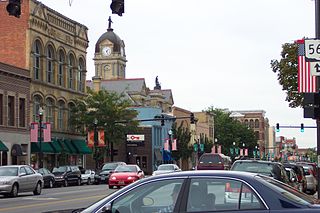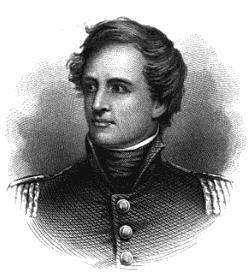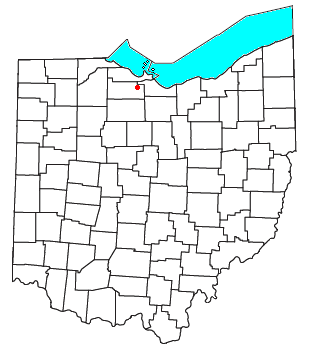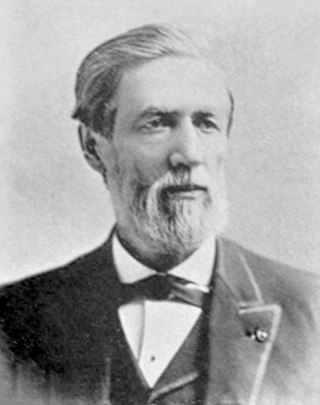
Findlay is a city in and the county seat of Hancock County, Ohio, United States. The second-largest city in Northwest Ohio, Findlay lies about 40 miles (64 km) south of Toledo. Its population was 40,313 at the 2020 census. The principal city of the Findlay micropolitan area, it is home to the University of Findlay, and the headquarters of Fortune 100 company Marathon Petroleum, which ranks 19th.

George Croghan was an American soldier who was a recipient of the Congressional Gold Medal.

Fort Harrison was a War of 1812 era stockade constructed in Oct. 1811 on high ground overlooking the Wabash River on a portion of what is today the modern city of Terre Haute, Indiana, by forces under command of Gen. William Henry Harrison. It was a staging point for Harrison to encamp his forces just prior to the Battle of Tippecanoe a month later. The fort was the site of a famous battle in the War of 1812, the siege of Fort Harrison in Sept. 1812 that was the first significant victory for the U.S. in the war. The fort was abandoned in 1818 as the frontier moved westward.

Fort Wadsworth is a former United States military installation on Staten Island in New York City, situated on The Narrows which divide New York Bay into Upper and Lower halves, a natural point for defense of the Upper Bay and Manhattan beyond. Prior to closing in 1994 it claimed to be the longest continually garrisoned military installation in the United States. It comprises several fortifications, including Fort Tompkins and Battery Weed and was given its present name in 1865 to honor Brigadier General James Wadsworth, who had been killed in the Battle of the Wilderness during the Civil War. Fort Wadsworth is now part of the Staten Island Unit of Gateway National Recreation Area, maintained by the National Park Service.

Jacob Ammen was a college professor, civil engineer, and a general in the Union Army during the American Civil War. His younger brother, Daniel Ammen, was an admiral in the United States Navy.

Thomas Ewing Jr. was an attorney, the first chief justice of Kansas and leading free state advocate, Union Army general during the American Civil War, and two-term United States Congressman from Ohio, 1877–1881. He narrowly lost the 1879 campaign for Ohio Governor.

James Findlay was an American merchant, politician and veteran of the War of 1812, having served with both the state militia and the United States Army. He was based in Cincinnati, Ohio after migrating there as a young man. He was elected as mayor of Cincinnati to two non-successive terms.

Vickery is an unincorporated community and a census-designated place in western Townsend Township, Sandusky County, Ohio, United States. It has a post office with the ZIP code 43464 and a volunteer fire department called Townsend Township FD. The population of the CPD was 101 at the 2020 census.
Edward Fenwick Dickinson was a U.S. Representative from Ohio for one term from 1869 to 1871. He was the son of Rodolphus Dickinson.

William Elisha Haynes was an American Civil War veteran who served two terms as a U.S. Representative from Ohio from 1889 to 1893. He was a cousin of George William Palmer.
Twenty-three currently active battalions of the Regular Army earned credit for campaigns during the War of 1812: two Air Defense Artillery battalions, six Field Artillery Battalions and seventeen Infantry battalions. These twenty-three battalions represent two Air Defense Artillery, four Field Artillery and seven Infantry regiments. Three additional Air Defense Artillery regiments have been awarded shared credit for War of 1812 campaigns, but the lineages of the artillery companies that earned those credits have not been perpetuated by currently active battalions.
The Fremont and Indiana Railroad existed in Northwest Ohio beginning in 1853.
Colby is an unincorporated community in Sandusky County, in the U.S. state of Ohio.
Erlin is an unincorporated community in Sandusky County, in the U.S. state of Ohio.
Tinney is an unincorporated community in Sandusky County, in the U.S. state of Ohio.
Whitmore is an unincorporated community in Sandusky County, in the U.S. state of Ohio.
Wightmans Grove is a census-designated place in Sandusky County, in the U.S. state of Ohio. Its population was 55 as of the 2020 census.
York is an unincorporated community in Sandusky County, in the U.S. state of Ohio.

David Glenn was of Irish descent and was born in 1753, likely in Pennsylvania but possibly in Virginia. He was one of the early settlers of Kentucky having accompanied James Harrod in founding Harrodstown in 1774, along with his older brother, Thomas. Today, Harrodsburg is considered the oldest permanent white settlement in Kentucky, being it was settled almost a full year before Boonesborough.
Morris' Company of Rangers (1789-1793) also referred to as the "Kanawha County Rangers" was a Ranger Company out of the newly established Kanawha County in 1789. From March to July 1789 the Kanawha County Rangers were under the command of Colonel George Clendenin until Clendenin was named as commander of the county militia by the Governor of Virginia. Captain John Morris assumed command of the unit where it became known as "Morris' Company of Ranger". The unit was called into federal service twice by the Secretary of War, General Henry Knox from May 1, 1791 until January 1, 1793 to fight and provide defense in the aftermath days of the American Revolution during the ratification process of the United States Bill of Rights, as well as the quelling Whiskey Rebellion and Indian Wars.










